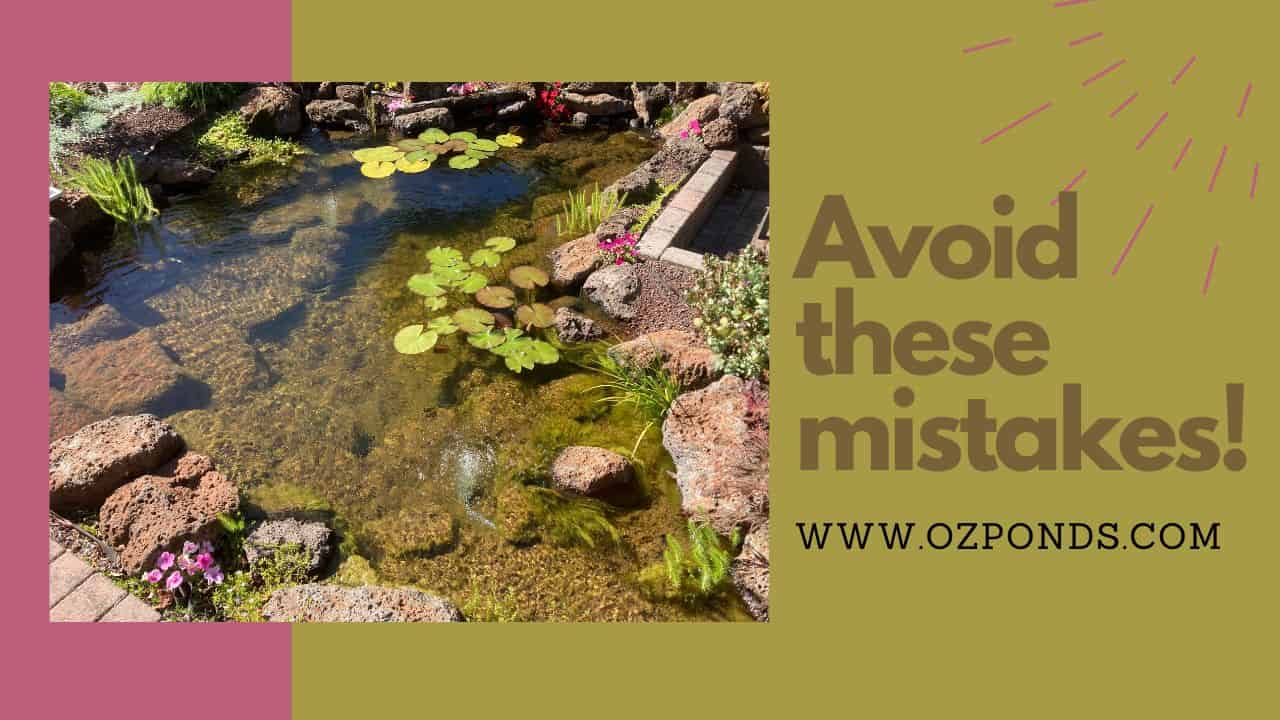Creating a pond can be a rewarding project, but it’s important to avoid common pitfalls to ensure your pond is beautiful, functional, and cost-effective. Here are some key points to keep in mind:
1. Establish a Clear Budget
Creating a pond is a significant investment of both time and money, making it essential to establish a clear budget from the outset. Trying to create an epic pond on a shoestring budget often leads to cutting too many corners, resulting in a poorly functioning pond that costs more in the long run to fix.
To avoid these pitfalls, plan your pond within your financial limits. For example, a simple water garden can be created for under $50 with just a pot, some substrate and plants. Something like this tiny pond in a pot.
A still small setup like a wine barrel fish pond, designed for higher fish loads with a bog filter, might cost around $200. Here is one I set up and it’s still one of my favourite ponds.
Larger projects, such as a thousand litre goldfish pond with a solar fountain and bog filter, can be achieved for under $500. Here’s a video of one I setup for a few hundred dollars.
For those looking to create more advanced ponds, costs can range significantly. An ecosystem pond using budget-friendly components might cost around $2,000. Below is a video I made showing how I constructed one of my ecosystem ponds on a budget.
Professional-grade ponds using high-end kits can cost anywhere from $500 to anywhere. These kits are handy for people that don’t want to do too much research and just want everything they need to build a pond. Here’s another video of me using an aquascapes pond kit to build a pond in one weekend.
Larger ponds, like recreational or swim ponds can get quite expensive. I managed to build my own for around $10,000 using cheaper materials. As a kit it would cost over $20,000 and if I got a contractor to build it, over $60,000.
By setting a clear budget and understanding the costs associated with different types of ponds, you can ensure your project stays on track and delivers a beautiful, functional water feature without unexpected expenses.
2. Choose the Right Location
Selecting the right location for your pond is crucial for both its aesthetic appeal and functionality.
A common mistake is placing the pond in a low area of the yard. While it might seem ideal because it naturally collects water, this can lead to poor water quality due to runoff, which carries nutrients and pollutants that are difficult to filter out. Instead, aim to build up the edges around the pond slightly to prevent runoff from entering.
Visibility is another important factor. Place your pond in a well-used and visible area, ideally where it can be enjoyed from inside the house. Ponds placed in far-off corners of the yard often go neglected.
For optimal enjoyment, position the pond close to your living spaces. This ensures that the pond is not only a beautiful focal point in your yard but also a space you will frequently visit and appreciate.
Sun and shade are also considerations, but they are secondary to the pond’s visibility and accessibility.
While both sun and shade have their advantages and disadvantages, the most important aspect is ensuring the pond is in a location where you and your family will spend time and enjoy its beauty. A well-placed pond enhances your outdoor space and becomes a cherished part of your daily life.
3. Depth Matters
One of the most common mistakes when building a pond is making it too shallow. This can lead to rapid temperature fluctuations, which stress out the fish and promote algae growth.
Even if you live in a region where the pond doesn’t freeze over, it’s important to make it at least 60 centimeters (two feet) deep. Deeper water provides a more stable environment, helping to maintain consistent temperatures and reduce stress on the fish.
In colder climates, ensuring your pond is deep enough to prevent it from freezing solid in winter is crucial. For those in milder climates, depth still plays a vital role in maintaining water quality. Shallow ponds heat and cool quickly, which can be harmful to aquatic life.
By digging deeper, you provide a more stable habitat that supports healthy fish and plant life.
Additionally, local regulations regarding pond depth and fencing requirements vary, so it’s important to check with your local council. Generally, ornamental fish ponds don’t require a fence, but it’s always best to confirm.
A deeper pond not only helps with temperature regulation but also enhances the overall health and longevity of your aquatic ecosystem.
4. Effective Filtration System
Effective filtration is critical for maintaining clear and healthy pond water. A good biological filter is essential, as it utilises beneficial bacteria to break down waste products and keep the water clean.
Nitrifying bacteria, which colonize on wet surfaces like rocks and gravel, play a crucial role in this process. These bacteria convert harmful ammonia from fish waste into less harmful substances, promoting a healthy aquatic environment.
Bog filters are particularly effective for natural filtration, providing ample surface area for bacteria to thrive. If you would like to build a pond using a bog filter, I recommend you use my handy pond formulas, this will help you size the filter to your ponds requirements.
Incorporating rocks and gravel into your pond design not only enhances its aesthetic appeal but also increases the biological filtration capacity. A setup like this mimics natural ecosystems, where water is naturally purified as it flows through various substrates.
When selecting a filtration system, you have the option to create your own or purchase pre-made systems. Not everyone wants to build their own filter, I get it.
DIY filters can be tailored to your specific needs and are often more cost-effective. However, plug-and-play systems are convenient and easy to install.
Regardless of the choice, understanding the nitrogen cycle and the mechanics of biological filtration is essential. This knowledge will make pond maintenance more manageable and ensure your pond remains a healthy and vibrant feature in your garden.
5. Pump Selection
Choosing the right pump is very important for the health and maintenance of your pond.
One of the most frequent questions among pond owners is whether a pump is necessary and what type is best. The answer is yes, a pump is essential, as it helps circulate water, ensuring proper aeration and filtration.
Submersible pumps are the most straightforward to install and operate, as they sit inside the water with all electrical components safely sealed. Low-voltage options are preferred for added safety. On the products page you can find links the the pond pumps I personally like to use.
For optimal performance and minimal maintenance, placing the pump in a skimmer box or intake bay (helpful article if you don’t know what a skimmer does), is advisable. This setup helps keep debris out of the pump, reducing the need for frequent cleaning.
You can easily create a simple skimmer by placing the pump inside a bucket and using rocks to create water tension that pulls debris off the surface. Here’s a video showing how I did just that.
Professional pond skimmers offer more sophisticated solutions but come at a higher price. Again I understand not everyone wants to go the DIY route.
It’s important to run the pump continuously, 24 hours a day, to maintain water quality. This means selecting an energy-efficient model is essential to keep operating costs manageable.
For water features like waterfalls or streams, a more powerful pump is required to achieve the desired effect. My formulas download will help you decide what size pump you need also.
While solar pumps can supplement circulation, they should not be relied upon as the primary pump due to their intermittent operation.
6. Proper Pond Liner
Choosing the correct liner is fundamental for the longevity and functionality of your pond.
For container ponds, using plastic materials that are food-grade and UV stabilised ensures safety for fish and durability against weather conditions.
When planning a more extensive in-ground pond, the selection of a high-quality liner becomes even more crucial. Options such as PVC and HDPE are available, but EPDM rubber liners are highly recommended due to their proven durability, flexibility, and ease of repair with simple patching.
Avoid the temptation to use cheap alternatives like tarps, which may seem cost-effective initially but can lead to significant issues over time, such as leaks and frequent replacements.
Investing in a good liner from the start will save time, effort, and money in the long run. Additionally, protecting your liner with a geotextile underlayment is a wise choice.
This layer acts as a barrier against rocks and tree roots, preventing punctures and extending the liner’s lifespan. While some might consider using old carpet or cardboard as underlayment, these materials can degrade and potentially harm the liner, making geotextile the more reliable option.
By planning carefully and choosing the right materials, you can create a stunning pond that enhances your outdoor space without breaking the bank. I hope this article and the my youtube channel are useful.
Thanks for reading and good luck with your pond project!

